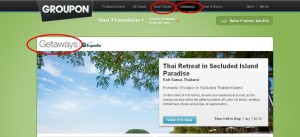Email Marketing: Groupon’s segmentation strategies across 115 million subscribers
Groupon is one of the biggest email marketing success stories you’ll ever hear. The daily deal company launched in November 2008 and was dubbed the fastest growing company ever last year by Forbes. Much of that growth is powered by targeted email messaging.
Today, Groupon sends about 5 billion emails each month, according to John Becvar, Sr. Director of Relationship Marketing at Groupon. I was lucky enough to hear Becvar comment on the company’s growth and email strategy during a panel session at ExactTarget’s Connections 2011 last week.
“We really began with no personalization and no segmentation,” Becvar said.
Becvar joined Groupon almost two years ago, back when its site featured a single deal each day in markets such as greater Chicago, with no deals on the weekends. Today, Groupon offers about 1,000 deals in the Chicago area in a given week, Becvar said.
“When I joined we had about 2 million subscribers. Based on our most-recent finding, we have over 115 million subscribers … We were in 20-some-odd markets when I joined. Now we’re in 45 countries and 500 markets … So we’ve obviously had to do a little bit of segmentation and personalization to stay relevant,” Becvar said.
Becvar described four types of segmentation Groupon uses for its email marketing:
Segmentation #1: Geographic
Groupon’s core business value proposition, Becvar said, is about discovering great local things to do. As the company’s reach expanded into more than 500 cities, it found more subscribers and adapted its definition of “local.”
“Being geographically relevant is the first most important thing,” Becvar said.
The company first segmented its list by general metro areas. Then, getting more specific, it targeted offers by zip code. Now the company wants to determine not only which offers are available near a subscriber’s home, but also which are available near places they often visit.
“It began by, ‘hey, do you live in Chicago? ‘[Then,] ‘do you live in this particular zip code?’ [Then,] ‘tell us where you live and where you work and where you play so I can give you an opportunity to do things that are around what you want to do,'” Becvar said.
Segmentation #2: Product type
Groupon was a pioneer in the daily deal market. Competitors have since emerged, some of which target niche categories such as travel or home goods.
Not to be outdone, Groupon’s marketers started offering specific types of local deals via email, not just local deals in general. A few examples of Groupon’s newer, more-specific email programs:
- Groupon Getaways – focuses on travel
- GrouponLive – focuses on live events
- Groupon Now! – same-day deals
“We operate under a philosophy that everyone is opted-in to theses communications globally, so they can opt-down if they don’t want to receive them as well,” Becvar said.
–
Segmentation #3: Lifecycle
Every subscriber was treated the same when Becvar joined the company, whether they bought zero deals or 100. Groupon has since “tried to evolve that into a more of a lifecycle strategy,” he said.
For example, new subscribers receive a series of 12 messages over their first 45 days in the program. The emails are designed to excite and engage new subscribers with the brand.
“For the best customers, we’re doing things to reward, recognize, and retain them as well,” Becvar said.
Segmentation #4: Personal data
The team also gathers data to personalize its emails. Three types of data Becvar mentioned that help drive Groupon’s personalization
- Self-reported – such as age, gender, zip code
- Appended – data purchased from third-party services
- Behavioral – data based on what subscribers click and purchase
Related resources
MarketingSherpa Email Summit 2012
Email Marketing: How Microsoft increased product engagement using email
Marketing Psychology: The behavioral triggers behind success at Amazon, Groupon and FarmVille
Email Marketing: How to overcome segmentation challenges and deliver targeted content
Email Relevance: 8 tactics for leveraging timing, segmentation and content
Email Test: Shorter copy brings 100% more total clickthroughs
Categories: Email Marketing Email Marketing, segmentation











the 4 consumer segmentation ideas listed here are at the heart of any type of marketing: email, social, and advertising. we work closely with our clients to map their customers into personas and lifecycle stages so that a targeted email campaign with relevant content can be delivered to each group. thanks for the post.